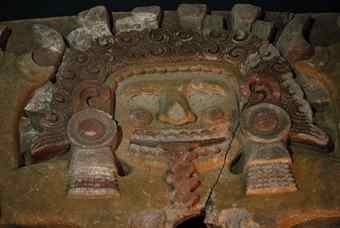Archaeologists found some of the richest and most unusual Aztec offerings ever in excavations under a mammoth slab depicting an earth goddess and said Wednesday they hope to uncover an emperor's tomb nearby.
 The seven offerings of strange and unparalleled oddities found under the stone slab depicting the goddess Tlaltecuhtli include the skeleton of a dog or wolf dressed in turquoise ear plugs, jadeite necklaces and golden bells on its feet.
The seven offerings of strange and unparalleled oddities found under the stone slab depicting the goddess Tlaltecuhtli include the skeleton of a dog or wolf dressed in turquoise ear plugs, jadeite necklaces and golden bells on its feet.
The 4-meter (13-foot) long carving of Tlaltecuhtli (tlahl-tay-KOO-tlee) was found in 2006 near the edge of the Templo Mayor pyramid in downtown Mexico City. It was lifted out in 2007 and archaeologists began digging underneath.
On Wednesday, the huge stone monument was put on display for reporters before its first public exhibition. The sculpture itself challenges the public perception of Aztec monuments as bare stone-colored carvings, because it preserves a half-dozen original colors in which it was originally painted, including rich ochre, red, yellow and blue hues.
Archaeologist Leonardo Lopez Lujan said the presence of shells from distant seas, gold earrings and collars as well as strange wooden daggers found under the slab suggest that a very important person is buried nearby.
"These are offerings that we have never seen before, and obviously they give us very good indications that at some point we can find a royal tomb," Lopez Lujan said.
The offerings — dedicated to gods, not rulers — are from such far-flung corners of the continent that "they are telling us we are dealing with a big, big empire," he said.
Historical records from the time of Spain's 1521 conquest and markings on the Tlaltecuhtli slab suggest the Aztec emperor Ahuizotl, who died in 1502, was cremated and his ashes buried somewhere at the foot of the Templo Mayor pyramid.
Researchers originally thought the tomb might lie directly below the slab. But with only about 2 meters (6½ feet) left to dig downward in 12.5-meter (41-foot) deep pits excavated since 2007, Lujan said researchers plan to dig a lateral tunnel 5 meters (16.4 feet) to the west, to see if they can find the cremated remains of Ahuizotl or his predecessors.
They would like to go farther with lateral excavations, but the water-soaked, unstable soil — and the possibility of damaging valuable, colonial-era buildings that still stand around the site — make that impossible. Radar and other images suggest soil disturbances near the current pit, but Lopez Lujan said those could be naturally caused.
Archaeologists have been looking for the tombs of the Aztec emperors for decades. Unlike the sepulcher of Mayan leaders, no Aztec royal burial site has ever been found.
Depicted as a woman with huge claws and a stream of blood flowing into her mouth as she squats to give birth, Tlaltecuhtli was believed to devour the dead and then give them new life. The god was so fearsome that Aztecs normally buried her depictions face down in the earth. However, this one was face-up.
In the claw of her right foot, the god holds a rabbit and 10 dots, indicating the date "10 Rabbit" — 1502, the year of Ahuizotl's death.
"What better monument for a funerary area ... than a goddess who devours the dead," Lopez Lujan said.
While the exhibition is dedicated to Moctezuma II — the last Aztec emperor, who took over from Ahuizotl and was defeated by the Spanish — the excavation is unlikely to shed any light on where his ashes lie.
Lopez Lujan said some versions say that while Moctezuma was cremated, his ashes may have been mixed with water and drunk by his subjects.
Source: Art Daily